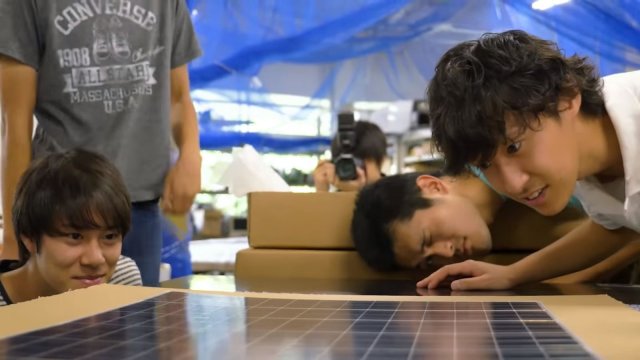
Dec 25, 2025
- Products & Solutions
- Stories
- Technology
- AI & Robotics
- R&D
- Business Solutions

The sun-scorched land. The savage desert -- In a solar car race, the key to victory lies in how efficiently you can convert sunlight into energy for the machine. In October 2015, one of the world's largest solar car races, the "Bridgestone World Solar Challenge (WSC) 2015," which covers a distance of 3,000 km from Darwin in the north to Adelaide in the south, was held. The conditions were so harsh that a few teams retired, but the Tokai University's solar car team supported by Panasonic completed the entire distance and crossed the finish line in third place. Panasonic's "HIT(R)" photovoltaic modules and high-capacity lithium-ion batteries helped the team achieve this feat.
During the race, the temperature rose to 45 degrees Celsius and sometimes as high as 60 degrees Celsius. The racecars have to travel at 100 km/h in such high temperatures. The essential point is how efficiently the teams can create the energy they need and charge their vehicles in the limited time available. The HIT photovoltaic modules (hereafter referred to as HIT modules) adopted by the Tokai University team are made up of the exact same cells as those that have been mass-produced and are commercially available. Panasonic's engineers fine-tuned them to make the HIT modules even more resilient against high temperatures and to significantly improve their conversion efficiency from 22.5% to 23.2%.
"It has higher performance and it's lighter, so we're excited to see its potential," said Mr. Kota Fukuda of Tokai University, the coach of the Tokai University team that built the solar car. They fixed the HIT modules in place one by one. And in September 2015, a test run was organized to check the vehicle's stability under high speed, brakes, suspension, etc. Panasonic's engineers also took part in this test. In addition, they checked the amount of energy created by the HIT modules and made other final adjustments in preparation for the race.
The long-awaited day of the race. Forty-three teams from 25 countries around the world gathered at Darwin, the starting point of the race. During the preliminary race, the Tokai University team finished in 8th place, 6th place in the Challenger Class, so they started from 6th place. High temperatures, dust, and strong winds assaulted them on the road. And each time a truck passed by, they were also attacked by strong side winds. During the day, the team overcame issues with the radio and flat tires, and at night, they had to find a good place to charge and camp. They adjusted the angle of the modules according to the movement of the sun and used every minute they could to charge.
On the 5th day of the race, the final day for the team, they charged the racecar under cloudy skies and headed for the goal in 4th place. With tenacity, they caught up to the team in third place with 60 km to go to the finish line.
"When we caught up to the team in third place, I really wanted to scream!" said the driver, Mr. Sagawa. "I didn't think we would be able to catch up. When Professor Kimura said to me, 'Don't worry about the energy. Just charge full speed ahead!' I was so excited."
Now in third place, the team continued to travel steadily and crossed the finish line having completed the entire distance at a little past noon on October 22 (Australian Central Standard Time).
Now in third place, the team continued to travel steadily and crossed the finish line having completed the entire distance at a little past noon on October 22 (Australian Central Standard Time).
Mr. Shingo Okamoto, general manager of the Panasonic Solar Business Unit, Technology Development Group, stated, "We wanted to take on this challenge to see if our solar cell technology truly is world-class. As engineers, we don't have textbooks. We have to find answers to the given task ourselves, and also overcome any obstacles that arise. It's a repetition of this process. I think the students and young engineers grew a lot during this race, and learned to develop something innovative on their own. They are the wellspring of technological development and what we cherish the most."
"I think the solar car race is an event that proves to the world that a society built on solar energy or other renewable energy is realizable," said General Director Kimura.
"HIT is continuing to evolve. It has the potential to become even more efficient 2 years, 4 years from now," says a member of the HIT module development team. Panasonic and Tokai University's challenge will continue.
Vehicle name: Tokai Challenger
Final rank: Third place
Total distance traveled: 3,022 km
Distance measured during competition: 2,998 km
Total time: 38 hours 50 minutes 7 seconds
Average speed: 89.41 km/h
* "HIT" is a trademark of the Panasonic Group.
[Short Ver. of behind the scenes] The amazing last spurt of the solar car powered by "HIT" photovoltaic modules
[Flash Report] Panasonic-Backed Tokai University Solar Car Team Completes 3,000km at #WSC2015
The content in this website is accurate at the time of publication but may be subject to change without notice.
Please note therefore that these documents may not always contain the most up-to-date information.
Please note that German, Spanish and Chinese versions are machine translations, so the quality and accuracy may vary.